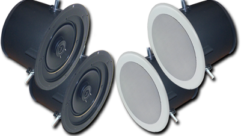
Picture This: Short Throws
Aug 1, 2007 12:00 PM,
By Jeff Sauer
The technology is out there, but is the price?

The Sanyo LP-XL50 extreme-short-throw projector can generate 80in.-diagonal
images 3in. from the screen.
One of the most intriguing announcements at InfoComm 07, at least to me, revolved around Sanyo’s LP-XL50 — an extreme-short-throw projector that can generate 80in.-diagonal images while positioned just 3in. from the screen. If there is one thing that is clear from the marketplace success of flatpanel TVs and monitors, it’s the fact that thin is clearly in. And, because there’s nothing thinner than a projected light on a flat surface, the XL50 could be just what presenters and educators need.
The caveat with front projection, comparatively speaking, is the distance between the projector and the screen that makes the overall infrastructure so much bigger. That projection distance leaves room for presenters to walk in front of the light and block the image. It leaves room for movie watchers to distract one another by standing up to get a snack or take a break. And, there’s room for painful and potentially harmful light getting into unsuspecting eyes, particularly the eyes of curious children.
Eliminating the distance the light has to travel could make front projection more practicable, if not more elegant, in many situations. By positioning a projector a few inches from the screen, presenters and educators can stand close to the screen without blocking the light. If the angle is extreme, even pointing arms and fingers might not obstruct the image. There would be no room for a person to accidentally walk through the light path, and therefore, a lot less opportunity for that curious child in a living room to look straight into the lamp.
SHORT-THROW LANDSCAPE
Sanyo is not the first company to offer an extreme-short-throw projector. NEC introduced the lens-less WT600 some three years ago with a multiple-mirror design that, in loose terms, emulated the light path of a rear-projection TV, but from in front of the screen and without the cabinet. More recently, NEC has upgraded to the WT610. NEC produces a 100in.-diagonal image with the projector just 24in. from the screen.
3M’s Vikuiti line of Super Close Projection uses proprietary Vikuiti lenses to accommodate the extreme angles of short-throw projection and still generate a rectangle image. 3M’s tabletop models, the Digital Media System 700 and 710, can produce a 60in. image from 24in. away or a 100in. image from 42in. The 3M wall-mountable Digital Media 800 includes a telescoping arm that produces images from 50in. to 85in. (the 800 and 815) or 60in. to 82in. (the 810) from similar distances.
Even Sanyo has tried ultra-short-throw projection in the past. The diminutive LP-XL40 with the big lens in front could produce a 60in. image at 30in. or an 80in. picture at about 40in.
However, the LP-XL50 is the shortest-throw projector to date. Sure, that “3in. from the wall” specification is a bit misleading. The projector itself is about 15in. deep, and it’s the near end of the projector that’s just 3in. from the screen with the lens at the other end of the oddly shaped unit — more than a foot away from that screen-side edge. Yet, even with the lens some 14in. from the screen, the XL50 is the shortest throw you’ll find out there.
Even more impressively, at least on the InfoComm show floor, that 80in. diagonal image looked awfully good. If you held up a long straight edge to the screen, you’d have noticed a little of the pin-cushioning that you’d expect from such an extreme projection angle, but with the naked eye, it was hard to see. What’s more, there were really no perceivable focus problems in the corners and along with sides of the image, and that’s a credit to Sanyo’s engineers.
IMAGE ISN’T EVERYTHING
As a technical achievement, Sanyo’s LP-XL50 gets high marks. It solves a major shortcoming (no pun intended) of front projection by making the overall infrastructure much more compact, and by doing so, making front projection a more practical option for small conference rooms, classrooms, and even home theaters. Indeed, while the LP-XL50 is not intended for the consumer or movie-viewing markets, the underlying technology could have a major impact in markets where thin is in and a bigger picture is definitely better.
Yet, it’s more than the 4:3 aspect ratio and presentation-centric features that make the LP-XL50 a no-go for consumers. Sanyo has put a tentative price out there as “less than $5,000” and that’s a huge premium for the novel technology. Indeed, as remarkable as Sanyo’s short-throw lens work is in the XL50, the basic specs are very ordinary. A native XGA resolution (1024×768) and 2000 lumens are comparable numbers to projectors that are more often in the $1,500 to $2,000 range.
Understandably, there are significant research and development costs to creating such a unique product, and Sanyo is entitled to make a profit. NEC’s first WT600 entered the market three years ago at a similarly high price ($5,995), although the WT610 is now down to $2,995.
The trouble is that front-projector prices have eroded quite dramatically over the last few years. Also at InfoComm 07, Epson introduced the SVGA, 2000-lumen, education-oriented PowerLite S5 for just $649 (although it’s already offered on the Epson website for $599). Obviously, the S5 is not in the same category as the short-throw XL50, but in many ways, it is the alternative, and if not that, then the 2200-lumen XGA PowerLite 77c costs just $749.
Novelty only goes so far, and the same holds true for innovative technology. Yes, there are likely to be organizations that will see the value of an extremely short-throw projector and be willing to pay a threefold or fourfold premium for it. However, that’s a tough sell, particularly when one of the primary target audiences is education — typically not known for casual spending.
Should Sanyo take a chance and drop the price of the XL50 dramatically? Obviously that’s a decision that needs to be based on the realities of cost of goods sold and expectations for sales volumes. But, would an extreme-short-throw projector do extremely well if the price premium weren’t so great?
Sure it could, just ask all of those presenters or teachers who have been blinded by the light before. The real question is how quickly Sanyo — or NEC, 3M, or any other manufacturer — can bring down the manufacturing costs to make that possible.









